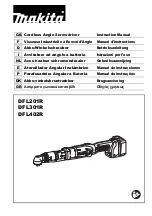
2
with conductive objects. Danger of electric shock or electrocution.
•
DANGER: If battery pack case is cracked or damaged, do not
insert into charger. Danger of electric shock or electrocution.
•
The charger and battery pack are specifically designed to work
together. DO NOT attempt to charge the battery pack with any
chargers other than the ones in this manual.
•
Do not expose charger to rain or snow.
•
These chargers are not intended for any uses other than charging
D
E
WALT rechargeable batteries. Any other uses may result in risk
of fire, electric shock or electrocution.
•
To reduce risk of damage to electric plug and cord, pull by plug
rather than cord when disconnecting charger.
•
Make sure cord is located so that it will not be stepped on, tripped
over, or otherwise subjected to damage or stress.
•
An extension cord should not be used unless absolutely necessary.
Use of improper extension cord could result in risk of fire, electric
shock, or electrocution. If an extension cord must be used, make
sure:
•
That the pins on plug of extension cord are the same number,
size and shape of those of plug on charger.
•
That extension cord is properly wired and in good electrical
condition; and
•
That the wire size is large enough for ac ampere rating of
charger as specified below.
Recommended Minimum AWG Size for Extension Cords
Total Extension Cord Length (feet) 25
50
75
100 125 150 175
Wire Gauge
18
18
16
16
14
14
12
•
The charger is ventilated through slots in the top and the bottom
of the housing. Do not place any object on top of charger or place
the charger on a soft surface that might block the ventilation slots
and result in excessive internal heat. Place the charger in a
position away from any heat source.
•
Do not operate charger with damaged cord or plug — have them
replaced immediately.
•
Do not operate charger if it has received a sharp blow, been
dropped, or otherwise damaged in any way; take it to an authorized
service center.
•
Do not disassemble charger; take it to an authorized service center
when service or repair is required. Incorrect reassembly may result
in a risk of electric shock, electrocution or fire.
•
To reduce risk of electric shock, unplug charger from outlet before
attempting any cleaning. Removing the battery pack will not reduce
this risk.
•
NEVER attempt to connect 2 chargers together.
•
DO NOT store or use the tool and battery pack in locations where
the temperature may reach or exceed 105°F (such as outside
sheds or metal buildings in summer).
•
The charger is designed to operate on standard electrical power
(120 volts). Do not attempt to use it on any other voltage!
•
WARNING: Don’t allow any liquid to get inside charger. Electric
shock may result. To facilitate the cooling of the battery pack after
use, avoid placing the charger or battery pack in a warm
environment such as in a metal shed, or an uninsulated trailer.
•
CAUTION: Never attempt to open the battery pack for any
reason. If the plastic housing of the battery pack breaks or cracks,
return to a service center for recycling.
SAVE THESE INSTRUCTIONS
Important Safety Instructions for Battery
Packs
THE BATTERY PACK IS NOT FULLY CHARGED OUT OF THE
CARTON! READ THE SAFETY INSTRUCTIONS BELOW AND
FOLLOW CHARGING NOTES AND PROCEDURES.
READ ALL INSTRUCTIONS
•
Do not incinerate the battery pack even if it is severely damaged or
is completely worn out. The battery pack can explode in a fire.
English
DW900,DW901/383609 bc 5/8/02 2:59 PM Page 2






































